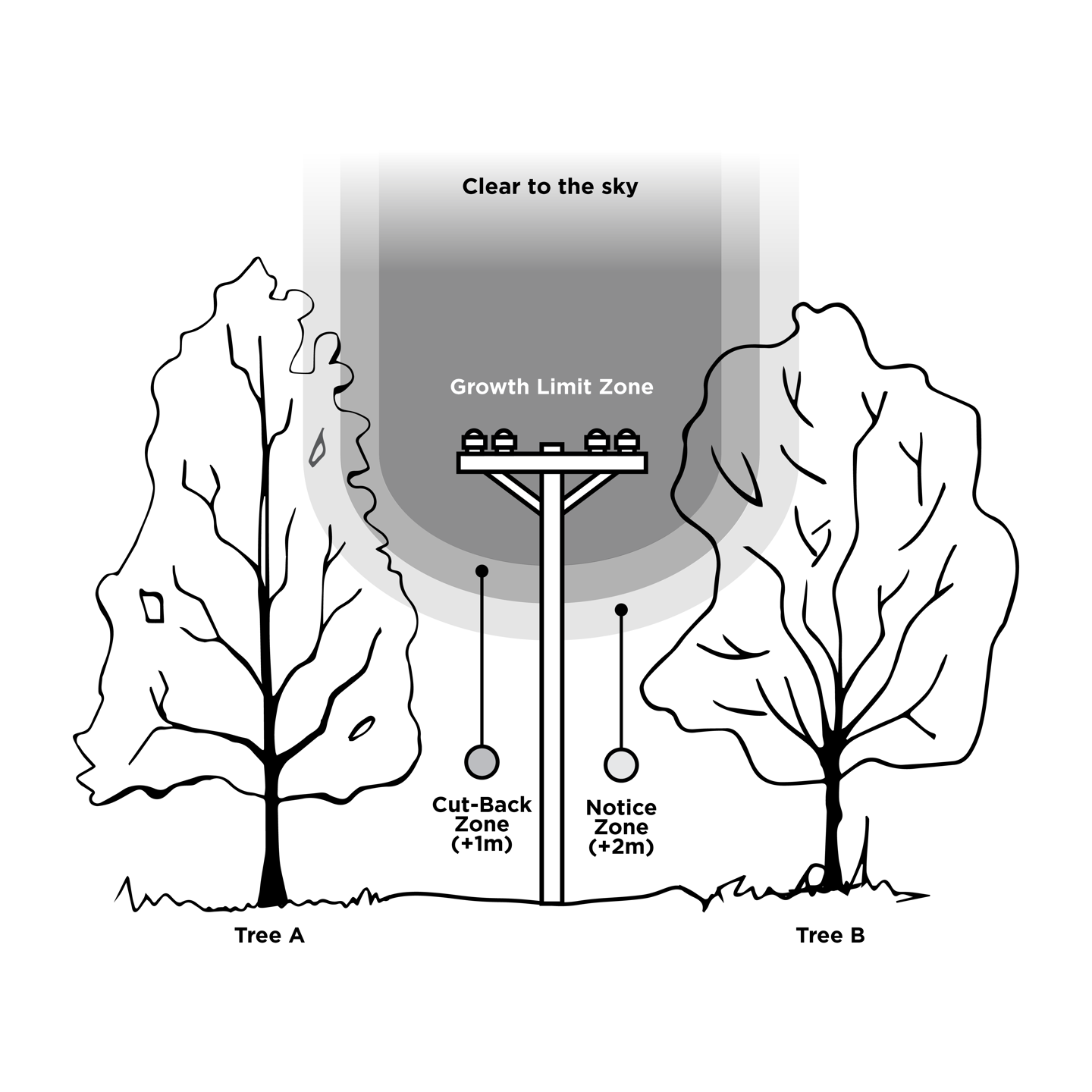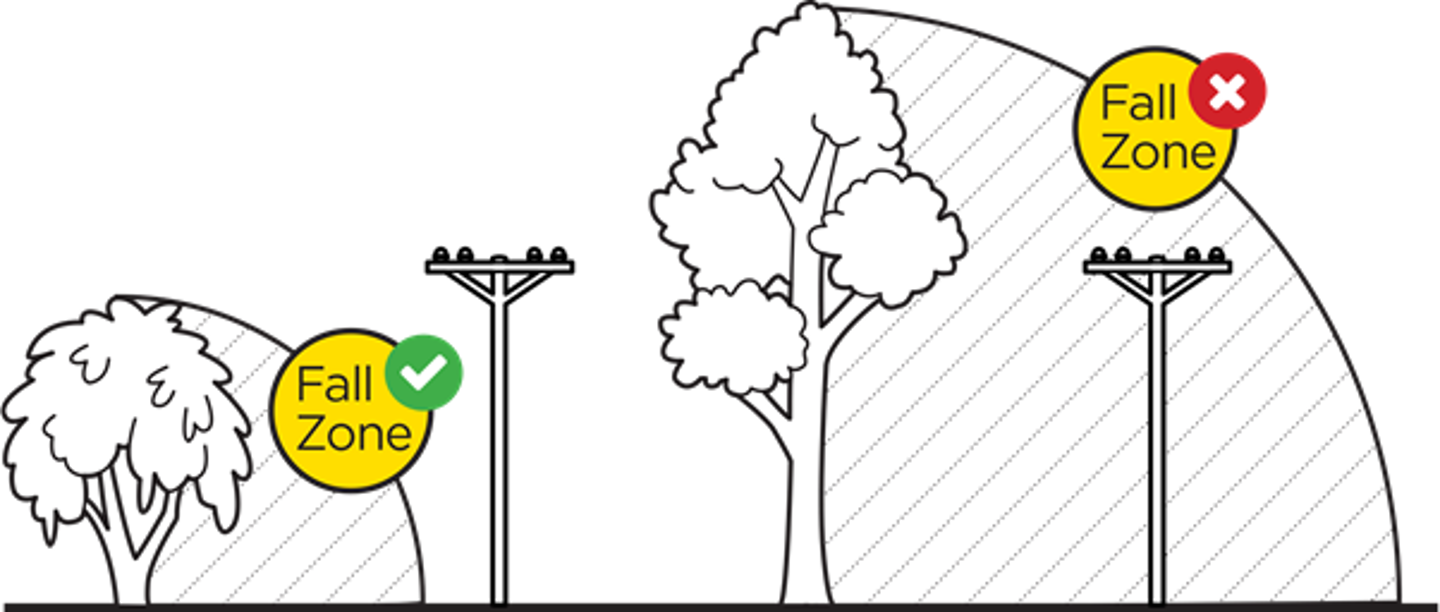Managing trees is a community responsibility. Working together, we can keep trees clear of powerlines, reduce the number of unexpected power outages and keep everyone safe.
You may not know it, but as a property owner, you are responsible for keeping the trees growing on your property clear of overhead power lines and underground cables. The Electricity (Hazards from Trees) Regulations 2003 set out your obligations as a tree owner and prescribe the minimum safe distances for trees growing near network power lines.
The regulations
In October 2024, the Regulations were updated to increase the minimum safe distances between
trees and power lines, and a new ‘clear to the sky’ requirement for some trees.
The regulations include:
- Any tree or vegetation that is considered a risk to our power equipment
- Minimum safe distances between trees and power lines (Growth Limit Zones)
- Responsibilities on tree owners and line owners for ensuring that clearances are maintained
- Setting out the penalties that each party faces for failing to comply with the regulations
- Outlining the arbitration process for handling disputes between tree owner and line owner
What are the different zones?
Growth Limit Zone: The minimum distance that a tree must be kept clear of overhead power lines
Cut-back Zone: Trees must be cut back so that they are outside of this zone
Notice Zone: Gives owners more notice to address the risk earlier
Fall Hazard Zone: Trees present a hazard if they fall and damage power lines. A tree’s fall hazard zone is the height of the tree plus 4 meters.
Note: Fall Zone trees are not currently covered by regulatory requirements. But if you own a tree that is within the fall zone and you have concerns about its health or safety, please notify us to discuss your options.
What are the minimum safe distances?
Overhead Line Voltage Growth Limit Zone (GLZ) Notice Zone
The size of the Growth Limit Zone varies depending on voltage level:
| Overhead Line Voltage | Growth Limit Zone (GLZ) | Cut-back Zone | Notice Zone |
| Power lines (230-400 V) | 0.5m | 1.5m | 2.5m |
| High voltage lines (6.6 kV) | 1.6m | 2.6m | 3.6m |
| High voltage lines (11kV) | 1.6m | 2.6m | 3.6m |
| High voltage lines (33 kV) | 2.5m | 3.5m | 4.5m |
| High voltage lines (50-66 kV) | 3.0m | 4.0m | 5m |
| High voltage lines (66 kV or more) | 4.0m | 5.0m | 6m |
The Notice and Growth Limit Zone requirements increase if the adjacent power line span is greater than 150m. In these cases, we will notify you of your obligations.
Notice, cut-back, growth and fall zones


Your responsibilities
Trimming and felling trees around power lines is very dangerous and could result in serious injury from electric shock or electrocution. For this reason, by regulation, only qualified and approved utility arborists are allowed to trim trees when they are within 4 metres of a power line.
If all parts of the tree are more than 4 metres away from overhead lines, you can safely trim the tree yourself or hire an arborist to do this for you. All care must be taken to prevent any part of the tree coming into contact with any power lines.
If any part of the tree is within 4 metres of the line or you have received a notice from us, you'll need a professional arborist authorised to work near power lines for your safety and the safety of others. Delta and Asplundh are our arboriculture Approved Contractors.
Penalties for non-compliance
Before we take any further action we will issue a Final Notice to remind you of your obligations and your final date for action. Doing nothing does not remove your responsibility under the regulations.
If you do not comply with a notice within the time specified, then you could be:
- Fined up to $10,000, plus $500 for every day the offence continues
- Held liable for costs of repairs if our lines or equipment are damaged by your tree
- Held liable for damage caused by broken power lines
- Held liable for damage caused by any resulting power surges affecting others
Disputes
If you believe that the tree does not pose a hazard to power lines, you can apply for dispensation within 5 working days of receiving this notice. If you’re unhappy with the dispensation decision, you can apply for arbitration within 5 working days of any dispensation decision. Information on how to apply for dispensation or arbitration is on our tree FAQ.
